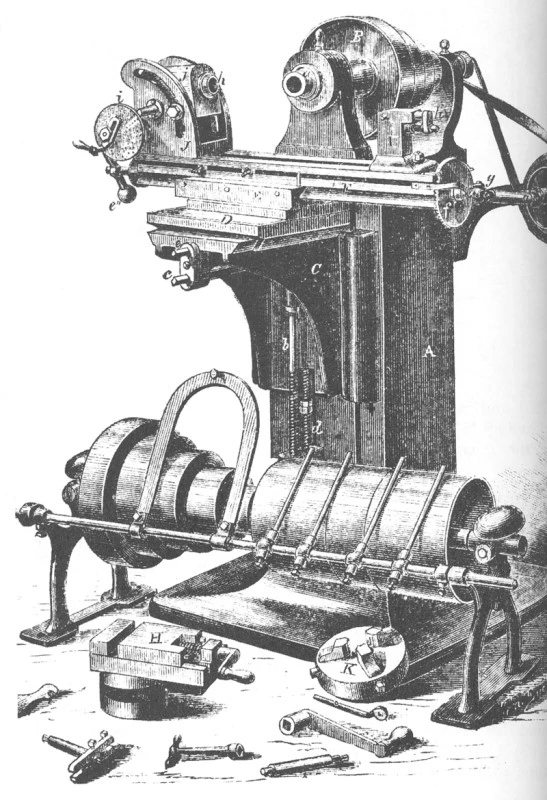
- English
- Español
- Português
- русский
- Français
- 日本語
- Deutsch
- tiếng Việt
- Italiano
- Nederlands
- ภาษาไทย
- Polski
- 한국어
- Svenska
- magyar
- Malay
- বাংলা ভাষার
- Dansk
- Suomi
- हिन्दी
- Pilipino
- Türkçe
- Gaeilge
- العربية
- Indonesia
- Norsk
- تمل
- český
- ελληνικά
- український
- Javanese
- فارسی
- தமிழ்
- తెలుగు
- नेपाली
- Burmese
- български
- ລາວ
- Latine
- Қазақша
- Euskal
- Azərbaycan
- Slovenský jazyk
- Македонски
- Lietuvos
- Eesti Keel
- Română
- Slovenski
- मराठी
- Srpski језик
CNC History: The Origin and Evolution of CNC Machining
2023-11-15
Currently, CNC machining is one of the popular manufacturing processes and is widely used in industrial applications. How much do you know about the history of CNC? What do you think people would say centuries ago about machines that made products/tools?
Due to the continuous development of technology, current CNC machining already has computerized functions. However, it does much more than that. In this article, HY will answer all of the above questions by delving into the history of computer numerical control.
What is CNC machining?
CNC machining is a manufacturing process in which a computer uses programming code to direct a machine to create a product. CNC (computer numerical control) machining is a subtractive manufacturing process. This means that computer programs instruct these tools, such as drills, mills, and lathes, to continuously cut the workpiece. This continues until the desired product is formed.


Advantages of using CNC machining
CNC machining has a wide range of industrial applications. For example, industries such as aerospace, petroleum, healthcare, and consumer electronics all rely on its advantages. The following are the advantages of CNC machining.
1.CNC machining is a high-precision process
Many industry parts require high-precision manufacturing processes. The top industry known for this requirement is the aerospace industry, whose parts require high quality and precision manufacturing processes. Therefore, they rely on the high-precision capabilities of CNC machining. When you choose us at HY, you'll be satisfied with our high tolerance standards, with parts manufactured to the tolerances of your drawings.
2. CNC machining of high-precision production parts
CNC machining with high precision
Another advantage of CNC machining is its precision. With skilled technicians and programming code, parts can be produced exactly as described in the CAD files. So if you have a lot of parts that fit into a larger assembly, there's no need to worry. They will work seamlessly with each other.
3. Material selection
CNC machining offers valuable advantages over other manufacturing processes such as 3D printing. This is because it supports many materials. Compared with 3D printing production, CNC processing basically has no material restrictions.
CNC processing materials
The only rule for choosing a material for CNC machining is its compatibility with the manufacturing process. Therefore, you need to consider the following factors:
Heat resistance.
Stress resistance.
hardness.
Tighten.
Design tolerances.
Depending on whether you have a CNC machine, you can check the supported materials before starting the process. At HY, we are open to a variety of materials, such as:
aluminum.
brass.
Stainless steel.
steel.
plastic.
You can find a full list of our support materials on our instant quote platform. Upload your design files and start your project today!
CNC history
When you look at the history of CNC machine tools, you know that CNC machining didn’t start out the way many people think. Currently, wherever we say or see CNC machining, we expect a computerized process.
This section will introduce you to the history of CNC machining, the first CNC machine tools, and their evolution over time.
The first CNC machine tool
The first CNC machine tool is credited to James Parsons in 1949. Parsons was a computer pioneer who worked on Air Force research projects. Research is on how to produce helicopter blades and better aircraft skins.
Parsons was able to calculate the helicopter airfoil coordinates using an IBM 602A multiplier. He then entered the data into a punched card and used it on a Swiss jig boring machine. This information led to the manufacture of many helicopter blades and aircraft skins. According to accepted CNC history, this is considered the first CNC machine tool. Parson later received the Joseph Maria Jacquard Memorial Award for his work.
Development of CNC technology
Before the first CNC machine tools were developed, some machines could be instructed to make other tools. This is called numerical control (NC). You should note that there is no computerization (C)
Parsons later developed the first CNC machine tools. With this development came an evolution. Below is a timeline of the evolution that has occurred throughout the history of CNC machining.


1952 – 1958
As the Cold War raged on, there was a need to increase efficiency and productivity in manufacturing many machines and weapons. So, in 1952, Richard Kegg, together with MIT, built the first CNC milling machine called the Cincinnati Milacron Hydrotel. Richard Kegg later patented a motor control device for positioning machine tools in 1958.
1967 – 1972
CNC machining is becoming more and more recognized around the world. This was due to the development of computer-aided design (CAD) and computer-aided machining (CAM) in 1972. The inclusivity of CAD and CAM in CNC machining has led to a huge growth in CNC machining. However, these two are not considered standard parts of the manufacturing process.
1976-1989
In 1976, 3D computer-aided design and computer-aided machining were included in CNC machining. In 1989, CAD and CAM software controlled machine tools became the industry standard for CNC machine tools.
Today’s CNC Industry
The development of CNC machine tools is unique. Going from simple machines controlled with punch cards to software-driven machines is mysterious. Due to developments, CNC machining became faster, more precise, and more accurate than NC and the first CNC machine tools.
CNC machining applications
Over time, CNC machining has developed into something that is widely recognized across the globe. Due to its advantages, many companies incorporate it into their manufacturing processes. CNC machining is not only suitable for industrial fields. It is equally important at the manufacturing level, which determines its use in industry. Here are the top industry applications and manufacturing capabilities for CNC machining.
Industrial applications
car
The automotive industry is a major user of CNC machining. They rely on manufacturing processes for prototyping and production.
Consumer electronics products
While it may come as a surprise, the consumer electronics industry also uses CNC machining. Companies like Apple use CNC machining in production. For example, the chassis of the Apple MacBook comes from CNC-machined aluminum.
Aerospace/Military
These two industrial sectors are the main users of CNC machining. This is because of its high precision and accuracy. CNC machining is also ideal as it can produce replacement and upgraded versions of any part on demand.
manufacturing applications
sample
CNC machining is a great way to create prototypes because it is autonomous. Once you have the CAD file, you can program it into the CNC machine and manufacturing will be completed in a short time. These properties make it ideal for sample making.
Production
CNC machining offers high precision and accuracy, making it ideal for manufacturing high-quality parts. Its extensive material support also improves its use in part manufacturing.
in conclusion
The history of CNC machining is unique. From the first CNC machines that required punched cards to software-based machines that required little guidance, it has evolved even further. CNC machining is a top manufacturing process incorporated into many industries.
Make HY your first choice for CNC machining
CNC machining is an important part of the main manufacturing process. This is evident in adoption across many industries and companies that provide services to people. When you choose HY, you can enjoy many benefits, including instant online quotes, manufacturing design analysis, robust engineering support, and more.




